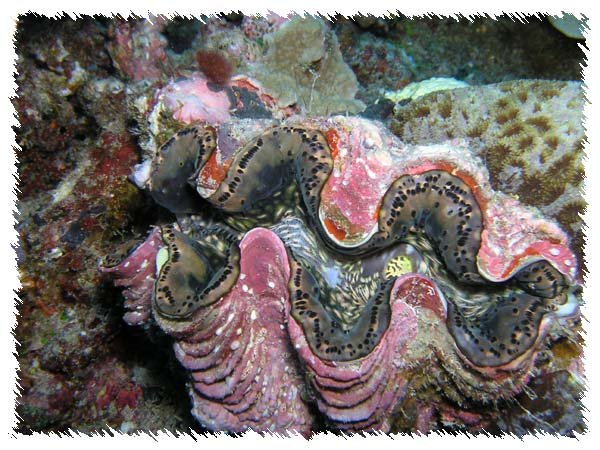
For serious divers, Palau is the shining star of Micronesia. This incredible cluster of islands and giant lagoon offer the most diverse range of diving experiences, plus several one-of-a-kind attractions that cannot be matched anywhere else in the world. Inside the lagoon is a glistening flat ocean surface, sprinkled with some 328 rock islands. These unusual formations are odd looking, mushroom shaped islands topped with a thick green growth of tropical foliage. Small marine organisms have spent centuries boring into the limestone base of these islands, sculpting them into fantasy mushrooms.
Clustered together, the Rock Islands form lovely and intricate passageways through which boats can motor at full speed. One of the most popular tours in Palau is a Rock Island cruise.
Beneath the surface, Palau has become world renowned for its spectacular drop-offs. Vertical walls begin knee deep, at a ridiculous depth of two feet, and plummet straight down to more than 1,000 feet. Diving these magnificent formations is an exhilarating experience, yet Palau offers much, much more. There are more than 50 World War II shipwrecks sunk in the lagoon - the remnants of a WWII, aircraft carrier attack. Most of the ships are Japanese, but the sunken aircraft are both American and Japanese.
A landlocked marine lake offers a bizarre opportunity to dive with a million non-stinging jellyfish.
There are blue holes, giant undersea tunnels, stalactite filled caves and a dozen more oddities that make Palau Lagoon different from any other place in the world.
Fabulous Wall Diving
 Palau is probably best known for its spectacular wall diving. These vertical drop-offs are along the outside edges of the barrier reef and islands. The wall dives provide an opportunity to enjoy 200 foot visibility and a spectacular array of colorful marine life. Some of the deep gorgonian fans reach gargantuan proportions - 15 feet tall and 10 feet wide!
Palau is probably best known for its spectacular wall diving. These vertical drop-offs are along the outside edges of the barrier reef and islands. The wall dives provide an opportunity to enjoy 200 foot visibility and a spectacular array of colorful marine life. Some of the deep gorgonian fans reach gargantuan proportions - 15 feet tall and 10 feet wide!
Ngemelis Drop-Off
On the north side of German Channel, the reef begins at two feet and plummets vertically to more than 1,000 feet. This site is world renowned for its giant gorgonian fans and magnificent soft corals in radiant yellows, purples, oranges and golds.
Blue Corner
One of Palau's most exciting sites, the wall makes a 90 degree turn, forming a sharp point that juts out into the open sea. Divers drift along the face of this vertical wall, letting the current carry them around the point. It is a high voltage dive during which divers encounter packs of Gray Reef Sharks swimming in the current, moving very close to the wall. This spot is famous for its Blue Marlin, Manta Rays, Dogtooth Tuna and schools of more than 100 Pacific Barracuda and other pelagics.
Siaes Tunnel
Siaes Tunnel is another one of those extraordinary dives that can be experienced only in Palau. This site is on the west side of the atoll. The vertical wall line juts out into the Philippine Sea, forming a very pointed corner. At that corner, a horizontal tunnel cuts right through the wall. This tunnel is huge, measuring some 50 feet high. The ceiling of the tunnel is approximately 80 to 90 feet, while the floor of the tunnel is at 120 to 130 feet. The interior is covered with soft corals and deepsea gorgonians fans. Halfway through the tunnel there is a "window" in the wall that looks out into the deep blue sea.
Big Drop-Off
This vertical wall dive begins in five feet. In a protected area, it is up close to Ngemelis Island. An absolutely vertical wall, it offers lots of large fans and a multitude of rare tropicals.
 New Drop-Off
New Drop-Off
Halfway between Blue Corner and Big Drop-off, this vertical wall is similar to Blue Corner in that a horizontal shelf sticks out of both ends. This spot is a favorite for Gray Reef Sharks, Dogtooth Tuna, Manta Rays and Blue Marlin.
Shark City
A vertical wall that forms a point jutting out into the open sea. A deep-V crevice cuts into the vertical face of the wall and there are several giant Table Corals measuring six to eight feet in diameter. This spot is a favorite haunt for several Gray Reef Sharks and a school of Barracuda.
Jellyfish Lake
There is no question that this is one of the strangest bodies of water known to divers. Millions of years ago, a geologic upheaval caused a small portion of Palau's lagoon to become trapped in a landlocked lake in the center of one of the larger Rock Islands. To reach this lake, divers must hike over a steep ridge and descend into a valley surrounded by jungle foliage. Although the lake is surrounded by high ridges on all side, it is fed seawater through a maze of cracks and fissures in the islands limestone base.
The main attraction of this mysterious, prehistoric lake is the million or more non-stinging jellyfish that inhabit it. Traveling in a tightly clustered school, this cloud of jellyfish moves around the lake-following the sun's rays. Instead of stinging and feeding upon stunned fish, these former predators have become undersea farmers-growing their own food through photosynthesis. Divers can reach out and touch these jellyfish without injury, even gathering them in their arms.
Chandelier Cave
Another fairyland experience is the exploration of a dazzling underground tunnel and cave system. Chandelier Cave is under and inside the island of Ngarol. The entrance to this labyrinth is a 10 foot wide tunnel opening in the side of the Rock Island. The top of the tunnel is approximately 15 feet below the surface.
This cave system is comprised of five or six distinct chambers that meander 400 feet or more under the island. Several of the chambers are filled with magnificently colored flowstones and crystalline stalactites. The freshwater portion is exceptionally clear as it forms a crystal lake.




